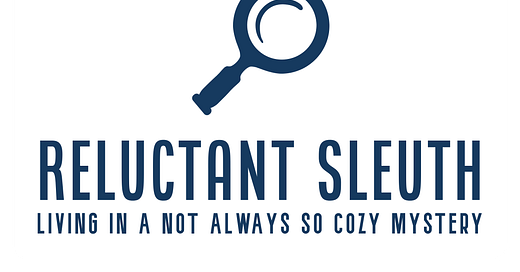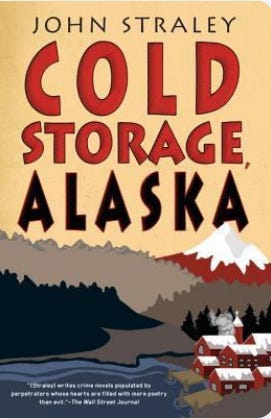Life is mysterious. I’m pretty much always on the lookout for clues. I like detective stories, especially when the sleuth, reluctant or otherwise, is a broken, complicated human, who may not know what they’re doing, but is nonetheless propelled by a need/desire/calling to bring about some kind of resolution. That’s noble, and necessary, and good, I think.
I’ll use this sub-stack to share my own writing, but also to reflect on things I’ve read or watched, that seem to offer clues.
Clues to what? How to make my own writing better. How to see a little more through the murky glass by which I view my own life and work. How to track down things I’ll want to read, and write about.
Maybe I’ll also connect with other reluctant sleuths.
To get started, I’ll borrow liberally from a blog I’ve been publishing for a few years, called Darrow Woods: Writer of Things. It’s possible you haven’t read it, which is another motivation for this sub-stack experiment.
This first re-purposed post is a notated list of what I’ve been reading lately. You can leave a note in the comments section about what you are reading and watching, and what’s good, or less good about it.
My son keeps lists of what he reads, listens to, and watches. I’ve long thought this a great idea. For 2023 I plan to keep a similar record, noting the date I finished. I’ve started with the fiction, but wonder about including non-fiction.
January 1. The Night Fire by Michael Connelly. 2019. This is the third novel to focus on LAPD night-shift detective Renee Ballard. It also the 22nd featuring Detective Harry Bosch.
January 4. The Foulest Things by Amy Tector. I read it because a reviewer mentioned Louise Penny liked it. It’s well constructed, with distinct characters, except for 2-3 women who worked with the protagonist- they all blended together, which was at times confusing. I might read more in this series, just because of the Ottawa setting.
January 5. The Recovery Agent, by Janet Evanovich. First in a new series by the author of the Stephanie Plum novels. Essentially the same style, and patterns of dialogue. Gabriella Rose chases after lost or stolen items. Stephanie Plum finds people who skip out on bail. The similarity was magnified because I listened to the audio version, which I think has the same narrator as the Plum stories.
January 17. The Scarecrow by Michael Connelly. Second in his series featuring reporter Jack McEvoy and FBI agent Rachel Walling. They work together to defeat and capture a serial killer who uses the internet to identify victims and set up others to take the fall for his crimes. McEvoy is the protagonist/narrator. He doesn’t have the depth of Bosch, Ballard, or Haller, but admittedly I’ve read more titles featuring them. I started the first in this series, The Poet, and quickly realized I’d already listened to it, probably the COVID summer I cycled big kilometres every day with a book in my ear.
January 23. The Overlook by Michael Connelly. Another Harry Bosch crime story. It follows the events of Echo Park. Harry and his ex-girl friend FBI agent Rachel Walling collaborate to solve a murder relatedmade to a terrorist attempt to acquire medical cesium to build a radioactive dirty bomb. I’ve never sat down to sort out how many Bosch books I’ve read, so it seems like each time, I jump in at a different place in his life. Connelly gives enough context to sort it out as I read. Wikipedia says it’s #13, from 2007. In it, Bosch can barely work his cell phone.
January 26. Cold Storage Alaska by John Straley. 2013. The first I have read by the former author laureate of Alaska, who’s also a criminal investigator. Quirky characters, a long slow burn of a plot, and evocative descriptions of locale. Part of a series about an isolated village on the Alaskan coast. I will definitely read more. I noted that he wrote “over the heads” of several major characters, allowing depth of character development, and a roving point of view that worked well.
January 30. Upright Women Wanted, by Sarah Gailey. 2020. This novella was recommended by my librarian daughter. It’s set in a future in which the United States is broken into smaller territories, and there is a war going on which claims much of the available wealth and resources. We meet a trio of traveling Librarians, who have license to travel the broken down highways that link communities in a new “old west”. The most common mode of transport is horse and wagon. The Librarians wear badges, ride horses, and wield six-shooters. They are also smugglers of contraband books and other media, as well as supplies for the “insurrectionists”. The background society is reactionary and homophobic. The Librarians are other than hetero-normative, which comes as a shock, and eventually a liberating relief to the protagonist, a young woman who is struggling to claim her own identity, and who fled her home community after her lesbian lover was hanged for possession of subversive materials. This novel is less about plot, and more about the protagonist’s movement from grief and fear and towards love, purpose, community, and self-acceptance. I appreciated this arc. At the same time, it felt a bit preachy and at times I wondered if I was reading a YA novel.
February 5. Desert Star by Michael Connelly, 2022. I’d been waiting to readt this one. Now-retired homicide investigator Harry Bosch is recruited by Detective Renee Ballard to serve as a volunteer on the LAPD “Cold Case” unit she has re-established. They work together closing long unsolved cases, one of which is close to Bosch’s heart. The description of genealogical investigation used in the Cold Case unit helped me understand a real-life news story about a murder case recently solved in Windsor, Ontario. One thing I respect about Connelly is he allows his protagonists to grow, change, and age in real-time. In this novel, Bosch is 72 and feeling it. He has serious health issues, and there are hints/red herrings dropped this is his last case. There are also “cameos” by his daughter Maddie, who is now an LAPD street cop, and his half-brother Mickey Haller, the defense attorney also known in another Connolly series as the Lincoln Lawyer.
February 5. Bloody Genius, by John Sandford, 2019. 12th in a series about Virgil Flowers, an investigator with Minnesota’s Bureau of Criminal Apprehension. I will read more of these. Flowers wears band t-shirts and jeans, lives on a horse farm, and takes on special assignments when a mess needs to be cleaned up. He’s also a part-time writer, and likes to read mystery fiction. In this one, he works his way through a James Lee Burke novel when he’s not hunting the killer of a university professor. I especially liked Sandford’s deft handling of a point of view behind, but not in Virgil’s head, and the way he used conversations between Virgil and other characters to reveal the detective’s thought process in searching for the killer. Less appealing in the book was the gratuitous use of profanity, in places that didn’t require it for drama or character revelation.
February 10. The Woman Who Married a Bear. 1992. This mystery by the former writer laureate of Alaska, is first in John Straley’s series about private investigator Cecil Younger. Straley’s descriptions of locale are incredible, and his turns of phrase are compact, nuanced, and very effective. The impression I had was of not so much being told a story as shown one, with me tasked to notice how elements could connect. I like this approach, and to some degree have attempted it in my own writing. It is a contrast with the “think it through out loud” method, that reminds the reader what needs to be considered, in the solution of the crime. The last page has a lovely line about the function of myth. The investigator reflects on the folktale that gave the book its title, The Woman Who Married a Bear, told to him by the matriarch who hired him to find her son’s killer. He wonders if the old woman intended to “ease me along the path of her own suspicions”, but he chose not to ask. He decided, and this is the line I love, “Most old stories don’t have anything to do with facts; they’re the box that all the facts came in.”
February 16. Holy Ghost by John Sandford. 2018. 11th in the Vernon Flowers series, immediately previous to Bloody Genius. I again enjoyed the narrator telling the story from “over the shoulder” of several characters, including at one point, “the shooter”. That was a careful tease that actually contributed to the confusion over their identity. I continue to also enjoy the way the protagonist talks out his theories of the crime, or lack of theories, with those in his company. It provides a particular kind of characterization, and avoids lines like “Flowers thought it possible the killer was one of the nuns from Uruguay.” (There are no Uruguayan religious in the book, so that wasn’t a spoiler.)
March 3. Babel, by R.F. Kuang. 2022. Kuang is a Chinese-American scholar, and fantasy writer. She holds degrees from Georgetown, Cambridge, Oxford, and is currently at Yale working on a PhD in Asian languages. Her familiarity with the upper strata of the academic world comes through in this historical fantasy, set in Victorian England. I enjoyed her depiction of that society, and the rarefied circles of Old Oxford, described from the perspective of people of colour who are recruited to do a special kind of magic that undergirds the industrial progress and expansion of the Empire. The full title: Babel, or the Necessity of Violence is a nod at one of the important themes of the book. The colonial project is furthered and maintained by systemic violence, racism, classism, and the subjugation of the people of non-white nations. To undo, or dismantle this empire would seem to require something like a civil war. She succeeds in making the novel a meditation on the human cost of imperial capitalism. My only criticisms are that her passion for linguistics leads her to some awkward word choices, and it’s a long read.

















